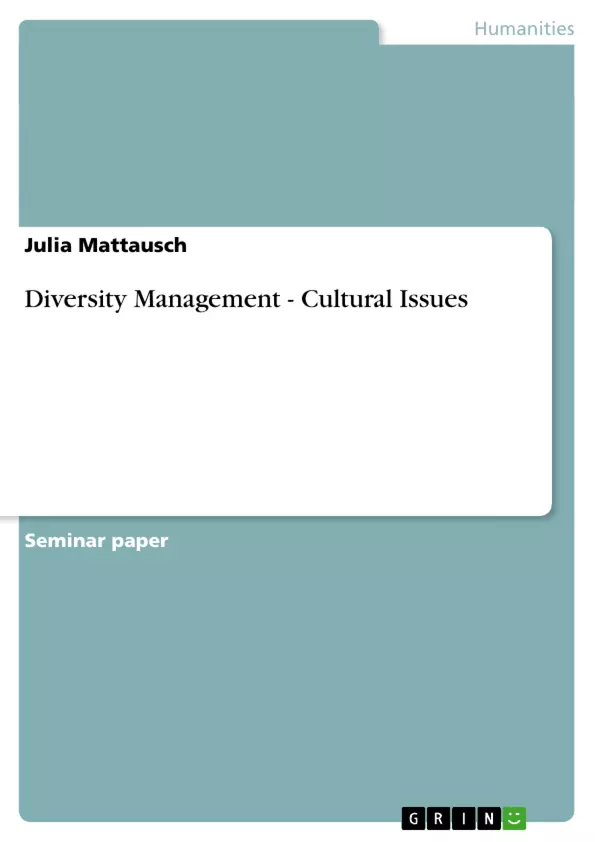As a result of the advanced globalization, organizations increasingly operate in international and global markets. They cooperate with companies from all over the world and em-ployees of different nationality are engaged. More and more people live and work in foreign countries. Between organizations, multinational corporations are becoming commonplace (Bhadury et al., 2001, cited by Seymen, 2006). Consequently, they have to deal with a wide range of diversity: different values, cultures, customs, lifestyle and manners encounter.
Also the growing level of domestic diversity is a reason for increasing cultural diversity (Stone, Stone-Romero, Lukaszewski, 2007). Essentially the United States are concerned, but also European countries. In the U.S. there are over 84 million members of the four primary minority groups like African-, Hispanic-, Asian- and Native-Americans. Another factor of increasing diversity is the rising immigration rate and the higher birth rates among ethnic minority groups (Stone et al., 2007).
Definitely, lots of advantages result of the above mentioned developments. Globalization has enabled transnational business and the communication all over the world has been extremely simplified. Markets for services and products have grown – the lack of boarders offers a lot of opportunities and flexibility. A high number of researchers argue that multiculturalism offers also benefits inside organizations. It is empirically proven that employees in multicultural organizations are more creative and have improved decision-making results (Adler, 1983, cited by Stone et al., 2007).
Anyway, with those developments occur some conditions, which cannot be ignored. The organizations have to challenge the improvement and the management of people on a global scale. This implicates some difficulties like matters of motivation, leadership, productivity and authority (Higgs, 1996, cited by Seymen, 2006). Researchers state, that while focussing on the positive effects of multiculturalism, its critical role in a high number of organizational processes has not been considered enough (Erez, 1994, cited by Stone et al., 2007). But there is no doubt that culture has impacts on diverse organizational processes.[...]
Inhaltsverzeichnis (Table of Contents)
- 1 Introduction
- 2 Definitions and specifications
- 2.1 Definitions of "culture"
- 2.2 Specification of Diversity Management
- 3 The influence of culture on human resource - recruitment
- 3.1 Culture as an influencing factor of national differences in selection practices?
- 3.2 Impact on acceptance of recruitment processes
- 3.2.1 Impact on desirability of job attributes
- 3.2.2 Impact on recruitment sources
- 3.2.3 Influence of values on job specifications
- 3.3 Impact on effectiveness of recruitment processes
- 3.3.1 Impact of values on effectiveness and design of the selection process
- 3.3.2 Influence of values on reactions to selection processes
- 4 Conclusion
Zielsetzung und Themenschwerpunkte (Objectives and Key Themes)
This paper explores the impact of cultural diversity on organizational processes, particularly focusing on human resource recruitment practices. The objective is to analyze how cultural differences influence the selection process, the acceptance of recruitment procedures, and ultimately, the effectiveness of these processes.
- The influence of culture on organizational processes, particularly human resource practices.
- The impact of cultural diversity on recruitment processes, including selection methods and acceptance.
- The role of cultural differences in shaping the effectiveness of recruitment practices.
- Exploring various definitions and understandings of the concept of "culture" in the context of organizations.
- The emergence of Diversity Management as a response to the increasing diversity and heterogeneity in the workforce.
Zusammenfassung der Kapitel (Chapter Summaries)
- Introduction: This chapter sets the context by highlighting the rise of globalization and its implications for organizational diversity. It discusses the growing importance of managing cultural diversity, citing the advantages of multiculturalism while also acknowledging the challenges it presents.
- Definitions and specifications: This chapter delves into the concept of "culture," exploring different definitions and perspectives from various fields. It also outlines the evolving concept of Diversity Management, highlighting its objectives and the shift towards a more inclusive and culturally sensitive approach.
- The influence of culture on human resource - recruitment: This chapter investigates the impact of culture on recruitment processes. It explores the role of culture in shaping national differences in selection practices and the ways in which cultural values influence the acceptance of recruitment processes and their effectiveness.
Schlüsselwörter (Keywords)
Diversity Management, cultural diversity, globalization, human resource management, recruitment, selection processes, cultural values, organizational processes, multiculturalism.
- Citar trabajo
- Julia Mattausch (Autor), 2007, Diversity Management - Cultural Issues, Múnich, GRIN Verlag, https://www.grin.com/document/88492



